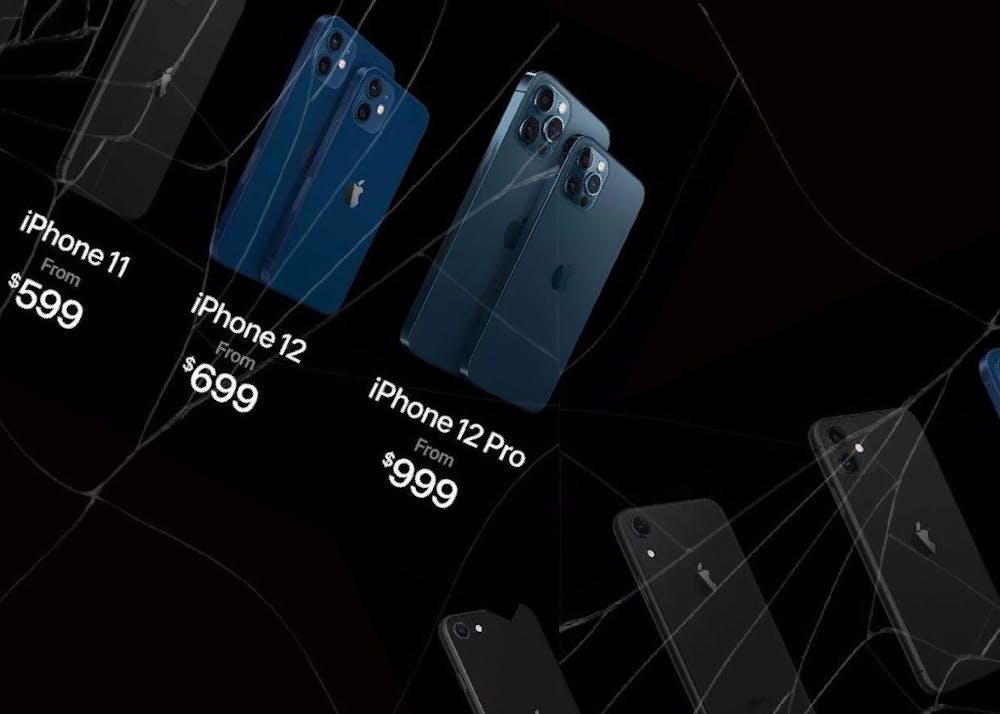iPhone season has begun. Every year since 2007, tech fanatics worldwide have braved long lines for the chance to step foot in Apple’s pristine stores and get their hands on the newest iPhone model. Apple Executives hold court at large press conferences, waxing poetic about the latest product’s improved features. With each new release, Apple executives convince consumers of one central premise: New is always better.
While some of Apple’s releases have actually made significant changes—such as the transition from the wide–bezeled iPhone 8 to the edge–to–edge display of the iPhone X in 2017—it’s getting more and more difficult to pinpoint tangible differences. Creating an excess of available models—the new iPhone 13 line comes with the mini, pro, and pro max—persuades customers to believe that some of the models are more reasonably priced than others. Our phones are more durable than ever, and yet, the new $1,000 iPhone 13 Pro sold out mere hours after becoming available for pre–order. In many ways, having the newest iPhone is a status symbol.
In the wake of the iPhone 13’s much anticipated release last week, it’s time to ask ourselves why we continue to be so fascinated by new tech when our old tech still works—and what impact this fascination has on our environment.
The concept of “commodity fetishism,” coined by Karl Marx in the 1860s, is defined as our tendency to imbue products for purchase with our desires for freedom and status. Exchange value is the relative price of items in relation to other items on the market, which is very different from an item’s actual use value. For example, a diamond necklace will always have more exchange value than water because of the social capital jewels carry, even though it isn’t essential for survival.
Our desire for new phones and other tech is driven by a fixation of the social and exchange value that new tech carries. Our smartphones are useful, but how much more powerful can a phone get? After all, will the faster processor or slightly more high–res camera on the new iPhone actually make our lives easier? The answers may logically be no, but the inescapable messaging associated with materialistic culture tells us yes—on social media, on television, even by the people we know.
Apple creates the supply and the demand, constantly encouraging consumers to upgrade unless they want to be left behind. Think back to when Apple took away the headphone jack for the release of the iPhone 7. At first, people hated this, but fast forward a couple months and wearing AirPods became a flex. What once was an object of ridicule became a social signifier of wealth and success.
Consumers have bought into the idea that new tech will improve their lives in some form. On Tiktok, popular user @itskeyonn uploaded a video lamenting his lack of an iPad: “Every time I see somebody whose life is together, or is at peace in life, they have an iPad,” he says. His sound has been used over 3300 times, usually over a video of someone unboxing their sleek new iPad. Now, as @itskeyonn claimed, their lives will be better as well.
Many of us treat our expensive, powerful technology like it is disposable, continuing our search for the most coveted new object. This psychological craving for novelty can be explained as an impulse to “buy how things make us feel.” The price point of new smartphones comes with an element of exclusivity and aspiration that satisfies our cultural fixation with “leveling” or “glowing” up. Owning the most recent smartphone can make us feel like we’re new and on trend too.
Though corporate green initiatives have focused our attention on the little things like plastic straws, our flippant disposal of technology is hurting the environment much more. While people are waiting longer to replace their smartphones, Americans alone throw out an estimated 416,000 phones each day, many of which are not recycled or reused.
The most harrowing aspect of all this smartphone waste is that many of us will never see the consequences of our actions. Instead, Americans send our e–waste away to West Africa and Asia, where it piles up in landfills. Even recycling damaged devices, the seemingly environmentally friendly option, doesn’t come without a cost. Precious metals are melted down to be repurposed, but in the process, workers at recycling plants are exposed to dangerous chemicals and long–term health consequences.
Apple has incentivized users to recycle their old phones through their “trade–in” model, but the company has also strategically made repairs difficult to push customers to buy a new device instead of sticking with their old one. Leaked training videos acquired by Vice display how Apple instructs their small number of authorized repair retailers to encourage customers to buy more expensive “authentic Apple” replacement parts. Corporations are facing increasing social pressure to go green, but revenue is still prioritized first.
What does all this mean for how we consume and engage with new tech? The issues of climate change and environmental waste often seem too enormous to comprehend. In truth, most of the responsibility should lay on companies, not individuals. We as consumers need to place pressure on brands to make products that are reusable and more affordable to repair. A growing “right to repair” movement is advocating for tech giants like Apple and Samsung to make their products easier for the general public to repair themselves. More convenient and safe recycling initiatives, such as the ATM–style old tech drop off EcoATM, are needed in more locations as well.
Always wanting what’s new is practically hardwired into our brains, and tech companies know how to take advantage of that. But holding corporations accountable doesn’t mean we can ignore the ramifications of e–waste and electronics overconsumption. If we want to keep this planet clean and livable for everyone, holding off on buying the latest iPhone every year is one step many of us can take.







